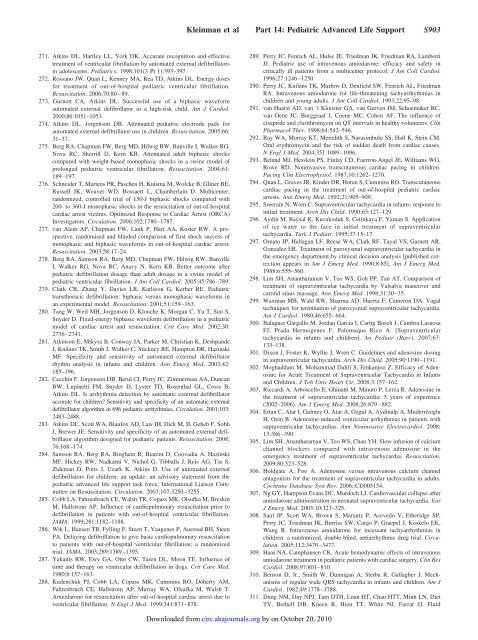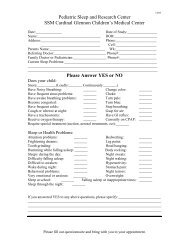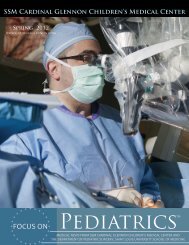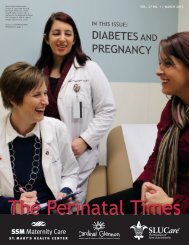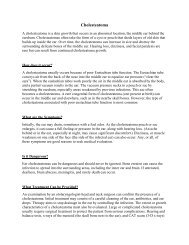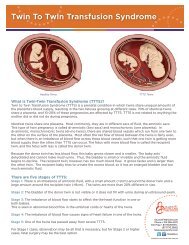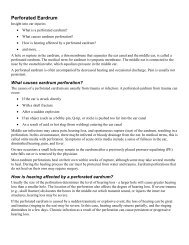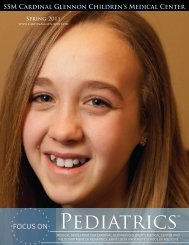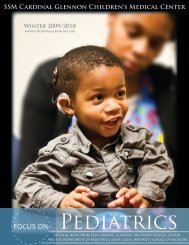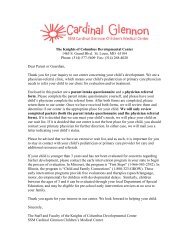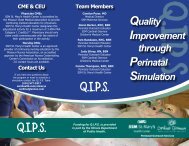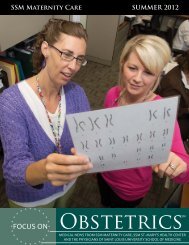pediatric-ALS-AHA-guidelines-circulation_11-2010 - SSM Cardinal ...
pediatric-ALS-AHA-guidelines-circulation_11-2010 - SSM Cardinal ...
pediatric-ALS-AHA-guidelines-circulation_11-2010 - SSM Cardinal ...
Create successful ePaper yourself
Turn your PDF publications into a flip-book with our unique Google optimized e-Paper software.
Kleinman et al Part 14: Pediatric Advanced Life Support S903271. Atkins DL, Hartley LL, York DK. Accurate recognition and effectivetreatment of ventricular fibrillation by automated external defibrillatorsin adolescents. Pediatrics. 1998;101(3 Pt 1):393–397.272. Rossano JW, Quan L, Kenney MA, Rea TD, Atkins DL. Energy dosesfor treatment of out-of-hospital <strong>pediatric</strong> ventricular fibrillation.Resuscitation. 2006;70:80–89.273. Gurnett CA, Atkins DL. Successful use of a biphasic waveformautomated external defibrillator in a high-risk child. Am J Cardiol.2000;86:1051–1053.274. Atkins DL, Jorgenson DB. Attenuated <strong>pediatric</strong> electrode pads forautomated external defibrillator use in children. Resuscitation. 2005;66:31–37.275. Berg RA, Chapman FW, Berg MD, Hilwig RW, Banville I, Walker RG,Nova RC, Sherrill D, Kern KB. Attenuated adult biphasic shockscompared with weight-based monophasic shocks in a swine model ofprolonged <strong>pediatric</strong> ventricular fibrillation. Resuscitation. 2004;61:189–197.276. Schneider T, Martens PR, Paschen H, Kuisma M, Wolcke B, Gliner BE,Russell JK, Weaver WD, Bossaert L, Chamberlain D. Multicenter,randomized, controlled trial of 150-J biphasic shocks compared with200- to 360-J monophasic shocks in the resuscitation of out-of-hospitalcardiac arrest victims. Optimized Response to Cardiac Arrest (ORCA)Investigators. Circulation. 2000;102:1780–1787.277. van Alem AP, Chapman FW, Lank P, Hart AA, Koster RW. A prospective,randomised and blinded comparison of first shock success ofmonophasic and biphasic waveforms in out-of-hospital cardiac arrest.Resuscitation. 2003;58:17–24.278. Berg RA, Samson RA, Berg MD, Chapman FW, Hilwig RW, BanvilleI, Walker RG, Nova RC, Anavy N, Kern KB. Better outcome after<strong>pediatric</strong> defibrillation dosage than adult dosage in a swine model of<strong>pediatric</strong> ventricular fibrillation. J Am Coll Cardiol. 2005;45:786–789.279. Clark CB, Zhang Y, Davies LR, Karlsson G, Kerber RE. Pediatrictransthoracic defibrillation: biphasic versus monophasic waveforms inan experimental model. Resuscitation. 2001;51:159–163.280. Tang W, Weil MH, Jorgenson D, Klouche K, Morgan C, Yu T, Sun S,Snyder D. Fixed-energy biphasic waveform defibrillation in a <strong>pediatric</strong>model of cardiac arrest and resuscitation. Crit Care Med. 2002;30:2736–2741.281. Atkinson E, Mikysa B, Conway JA, Parker M, Christian K, DeshpandeJ, Knilans TK, Smith J, Walker C, Stickney RE, Hampton DR, HazinskiMF. Specificity and sensitivity of automated external defibrillatorrhythm analysis in infants and children. Ann Emerg Med. 2003;42:185–196.282. Cecchin F, Jorgenson DB, Berul CI, Perry JC, Zimmerman AA, DuncanBW, Lupinetti FM, Snyder D, Lyster TD, Rosenthal GL, Cross B,Atkins DL. Is arrhythmia detection by automatic external defibrillatoraccurate for children? Sensitivity and specificity of an automatic externaldefibrillator algorithm in 696 <strong>pediatric</strong> arrhythmias. Circulation. 2001;103:2483–2488.283. Atkins DL, Scott WA, Blaufox AD, Law IH, Dick M, II, Geheb F, SobhJ, Brewer JE. Sensitivity and specificity of an automated external defibrillatoralgorithm designed for <strong>pediatric</strong> patients. Resuscitation. 2008;76:168–174.284. Samson RA, Berg RA, Bingham R, Biarent D, Coovadia A, HazinskiMF, Hickey RW, Nadkarni V, Nichol G, Tibballs J, Reis AG, Tse S,Zideman D, Potts J, Uzark K, Atkins D. Use of automated externaldefibrillators for children: an update: an advisory statement from the<strong>pediatric</strong> advanced life support task force, International Liaison Committeeon Resuscitation. Circulation. 2003;107:3250–3255.285. Cobb LA, Fahrenbruch CE, Walsh TR, Copass MK, Olsufka M, BreskinM, Hallstrom AP. Influence of cardiopulmonary resuscitation prior todefibrillation in patients with out-of-hospital ventricular fibrillation.JAMA. 1999;281:<strong>11</strong>82–<strong>11</strong>88.286. Wik L, Hansen TB, Fylling F, Steen T, Vaagenes P, Auestad BH, SteenPA. Delaying defibrillation to give basic cardiopulmonary resuscitationto patients with out-of-hospital ventricular fibrillation: a randomizedtrial. JAMA. 2003;289:1389–1395.287. Yakaitis RW, Ewy GA, Otto CW, Taren DL, Moon TE. Influence oftime and therapy on ventricular defibrillation in dogs. Crit Care Med.1980;8:157–163.288. Kudenchuk PJ, Cobb LA, Copass MK, Cummins RO, Doherty AM,Fahrenbruch CE, Hallstrom AP, Murray WA, Olsufka M, Walsh T.Amiodarone for resuscitation after out-of-hospital cardiac arrest due toventricular fibrillation. N Engl J Med. 1999;341:871–878.289. Perry JC, Fenrich AL, Hulse JE, Triedman JK, Friedman RA, LambertiJJ. Pediatric use of intravenous amiodarone: efficacy and safety incritically ill patients from a multicenter protocol. J Am Coll Cardiol.1996;27:1246–1250.290. Perry JC, Knilans TK, Marlow D, Denfield SW, Fenrich AL, FriedmanRA. Intravenous amiodarone for life-threatening tachyarrhythmias inchildren and young adults. J Am Coll Cardiol. 1993;22:95–98.291. van Haarst AD, van ’t Klooster GA, van Gerven JM, Schoemaker RC,van Oene JC, Burggraaf J, Coene MC, Cohen AF. The influence ofcisapride and clarithromycin on QT intervals in healthy volunteers. ClinPharmacol Ther. 1998;64:542–546.292. Ray WA, Murray KT, Meredith S, Narasimhulu SS, Hall K, Stein CM.Oral erythromycin and the risk of sudden death from cardiac causes.N Engl J Med. 2004;351:1089–1096.293. Beland MJ, Hesslein PS, Finlay CD, Faerron-Angel JE, Williams WG,Rowe RD. Noninvasive transcutaneous cardiac pacing in children.Pacing Clin Electrophysiol. 1987;10:1262–1270.294. Quan L, Graves JR, Kinder DR, Horan S, Cummins RO. Transcutaneouscardiac pacing in the treatment of out-of-hospital <strong>pediatric</strong> cardiacarrests. Ann Emerg Med. 1992;21:905–909.295. Sreeram N, Wren C. Supraventricular tachycardia in infants: response toinitial treatment. Arch Dis Child. 1990;65:127–129.296. Aydin M, Baysal K, Kucukoduk S, Cetinkaya F, Yaman S. Applicationof ice water to the face in initial treatment of supraventriculartachycardia. Turk J Pediatr. 1995;37:15–17.297. Ornato JP, Hallagan LF, Reese WA, Clark RF, Tayal VS, Garnett AR,Gonzalez ER. Treatment of paroxysmal supraventricular tachycardia inthe emergency department by clinical decision analysis [published correctionappears in Am J Emerg Med. 1990;8:85]. Am J Emerg Med.1988;6:555–560.298. Lim SH, Anantharaman V, Teo WS, Goh PP, Tan AT. Comparison oftreatment of supraventricular tachycardia by Valsalva maneuver andcarotid sinus massage. Ann Emerg Med. 1998;31:30–35.299. Waxman MB, Wald RW, Sharma AD, Huerta F, Cameron DA. Vagaltechniques for termination of paroxysmal supraventricular tachycardia.Am J Cardiol. 1980;46:655–664.300. Balaguer Gargallo M, Jordan Garcia I, Caritg Bosch J, Cambra LasaosaFJ, Prada Hermogenes F, Palomaque Rico A. [Supraventriculartachycardia in infants and children]. An Pediatr (Barc). 2007;67:133–138.301. Dixon J, Foster K, Wyllie J, Wren C. Guidelines and adenosine dosingin supraventricular tachycardia. Arch Dis Child. 2005;90:<strong>11</strong>90–<strong>11</strong>91.302. Moghaddam M, Mohammad Dalili S, Emkanjoo Z. Efficacy of Adenosinefor Acute Treatment of Supraventricular Tachycardia in Infantsand Children. J Teh Univ Heart Ctr. 2008;3:157–162.303. Riccardi A, Arboscello E, Ghinatti M, Minuto P, Lerza R. Adenosine inthe treatment of supraventricular tachycardia: 5 years of experience(2002–2006). Am J Emerg Med. 2008;26:879–882.304. Ertan C, Atar I, Gulmez O, Atar A, Ozgul A, Aydinalp A, MuderrisogluH, Ozin B. Adenosine-induced ventricular arrhythmias in patients withsupraventricular tachycardias. Ann Noninvasive Electrocardiol. 2008;13:386–390.305. Lim SH, Anantharaman V, Teo WS, Chan YH. Slow infusion of calciumchannel blockers compared with intravenous adenosine in theemergency treatment of supraventricular tachycardia. Resuscitation.2009;80:523–528.306. Holdgate A, Foo A. Adenosine versus intravenous calcium channelantagonists for the treatment of supraventricular tachycardia in adults.Cochrane Database Syst Rev. 2006;:CD005154.307. Ng GY, Hampson Evans DC, Murdoch LJ. Cardiovascular collapse afteramiodarone administration in neonatal supraventicular tachycardia. EurJ Emerg Med. 2003;10:323–325.308. Saul JP, Scott WA, Brown S, Marantz P, Acevedo V, Etheridge SP,Perry JC, Triedman JK, Burriss SW, Cargo P, Graepel J, Koskelo EK,Wang R. Intravenous amiodarone for incessant tachyarrhythmias inchildren: a randomized, double-blind, antiarrhythmic drug trial. Circulation.2005;<strong>11</strong>2:3470–3477.309. Haas NA, Camphausen CK. Acute hemodynamic effects of intravenousamiodarone treatment in <strong>pediatric</strong> patients with cardiac surgery. Clin ResCardiol. 2008;97:801–810.310. Benson D, Jr., Smith W, Dunnigan A, Sterba R, Gallagher J. Mechanismsof regular wide QRS tachycardia in infants and children. Am JCardiol. 1982;49:1778–1788.3<strong>11</strong>. Dung NM, Day NPJ, Tam DTH, Loan HT, Chau HTT, Minh LN, DietTV, Bethell DB, Kneen R, Hien TT, White NJ, Farrar JJ. FluidDownloaded from circ.ahajournals.org by on October 20, <strong>2010</strong>


